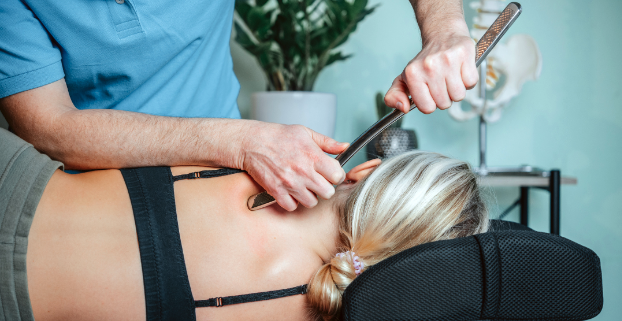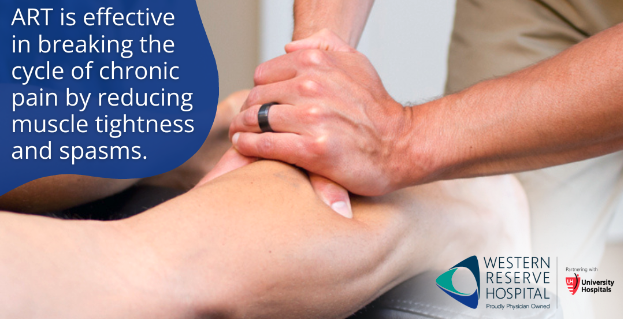Chronic pain and muscle-related issues affect many people, often making daily activities difficult and reducing their quality of life. At Western Reserve Hospital's Pain Care Center, Dr. Jeremy Coffey offers an effective solution through Active Release Technique (ART). This blog explores what ART is, how it works, and its benefits, using insights from an interview with Dr. Coffey.
What is Active Release Technique?
Active Release Technique (ART) is a specialized type of myofascial release or massage technique that targets the muscles and fascia. Unlike traditional chiropractic methods, which primarily focus on bones and joints, ART works directly on the soft tissues.
"Active Release Technique is a kind of myofascial release, or massage technique that is different because it works more on the muscles and the fascia, which is in between the skin and the muscles," explains Dr. Coffey. "Chiropractic techniques, generally speaking, work on the bones and joints, and Active Release Technique and other kind of myofascial techniques would work more so in the muscles themselves."
How Does ART Work?
Physiologically, ART addresses the issues within the contractile tissues of the muscles. "As they contract sometimes, then they won't release. And so as that muscle kind of tightens up, it can form knots," Dr. Coffey explains. "Something like Active Release Technique is trying to pin that muscle down and stretch through the normal kind of range of motion for that muscle, which helps to break down the tightness or the contraction that's happening."

The technique also targets the fascia, a connective tissue between the skin and muscles that can develop scar tissue and tightness. ART helps break down these adhesions, allowing for improved movement and function.
Common Conditions Treated by ART
ART is versatile and can treat a range of muscle-related conditions."It can be a whole range of different injuries or conditions from kind of spinal conditions, which chiropractors generally do, to knees, hips, ankles, shoulders, so tendinitis, type things, muscle spasms, knots, just kind of different things like that that are often more muscular in nature," says Dr. Coffey. "But it goes right along with the chiropractic because there's often both a muscular piece and a joint piece to a lot of these issues and injuries."
The ART Process
Assessing and targeting the appropriate muscles and soft tissues is a crucial part of the ART process. Dr. Coffey begins by discussing the patient's history and symptoms to identify the affected areas. He then uses palpation to feel tight muscles, knots, and scar tissue.
"Part of that is history, kind of talking with the patient and discussing what they're experiencing and what they're feeling, and that can kind of tighten up what muscles and what soft tissue we're looking at," he notes. "Then feel, and you feel where those muscles might be tight. Feel where those muscles might have knots or scar tissue or different things like that. And then you can kind of target it even more specifically."
Chiropractors can become certified in ART through various post-graduate sessions and continuing education seminars. These training programs help practitioners refine their skills and stay updated on the latest techniques.
ART in Practice
Patients might experience a sensation similar to a deep tissue massage during an ART session. There can be some soreness afterward, but this is a normal part of the healing process. Dr. Coffey suggests, "If you drink plenty of water, different things like that, that can help lessen some of that soreness."
Integrating ART into a comprehensive treatment plan for managing chronic pain involves addressing both the joints and the muscular tissues. This holistic approach helps break the cycle of pain and tightness, leading to better overall function.
Benefits and Effectiveness of ART
ART is particularly effective in breaking the cycle of chronic pain by reducing muscle tightness and spasms. It works well with other treatments, such as physical therapy, acupuncture, and traditional chiropractic adjustments.

"Chronic pain, there are a variety of different aspects to it. And one of the biggest things that I've found is there's a big muscular aspect where the muscles tighten down, spasm, which kind of furthers the irritation and then just creates this cycle of pain and tightness and spasms," Dr. Coffey explains. "What ART or other kinds of myofascial techniques can do is help to break that cycle, help to decrease the tightness, decrease the spasm, and decrease the overall pain that someone is experiencing from chronic pain."
Patient Suitability and Outcomes
Determining if a patient is a good candidate for ART involves assessing the presence of a muscular component in their condition. Conditions such as tendinitis, tendinosis, and bursitis are particularly suitable for ART.
"Any kind of patient that has a muscular component can be good to do kind of myofascial release for," says Dr. Coffey. "So anytime there is that kind of muscular component, like spasms, tightness, or a specific diagnosis, then that can help lead us and tell us that they might be a good candidate for this treatment."
he number of sessions needed for improvement varies based on the individual's condition. Acute problems may respond quickly, while chronic issues might take longer. Dr. Coffey typically evaluates progress after four sessions to determine the next steps.
Advice for Patients
To maintain the benefits of ART outside the clinic, Dr. Coffey emphasizes the importance of staying active. Physical activity helps reinforce muscle function and strength, contributing to long-term improvement.
"Activity is a good thing. The body's meant to move, and walking, standing, doing different things around the house is a great thing because it helps reinforce the way the muscles are supposed to be, and reinforce the strength in a lot of different ways," he advises. "As you move, as you get that activity, it can build up the muscular strength. It can build up a kind of function there."

Learn More About Active Release Technique and How It Could Help You
Active Release Technique offers a powerful solution for those suffering from chronic pain and muscle-related issues. By targeting both the muscles and fascia, ART helps break the cycle of pain and tightness, improving function and quality of life. Dr. Jeremy Coffey's expertise at Western Reserve Hospital's Pain Care Center ensures patients receive the best possible care through this innovative technique.
For more information or to schedule an appointment with Dr. Jeremy Coffey, contact Western Reserve Hospital's Pain Care Center today.
